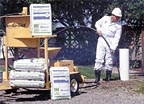
Most states have laws governing well construction, which include grouting the entire length of the casing from the top of the aquifer to land surface, particularly for public supply wells. Extra levels of safety are warranted for wells involving wells serving hundreds or thousands of people.
In some geographical areas, an argument can be made that the geology is well known and only permeable sands exist from land surface to the top of the producing zone, and prevention of contamination or loss of artesian pressure is not served by grouting the annular space outside of the well. The cost of grouting of a deep domestic well for a single family can be a large cost of the well, but may not be worth the added expense for the relatively little protection grouting would provide.
At a minimum, the bottom 20 feet of the outside of the well casing should be grouted in areas where confining beds are known to be absent. In areas where confining beds are present, overlying the main aquifer grouting of the entire casing with neat Portland cement (5.5 gallons of water per 94-pound sack of Type I Portland cement) is recommended. Factors to consider include location of septic tanks, potential upgradient sources of contamination, site-specific hydrogeology and the land use in surrounding areas.
All wells should have the casing at land surface protected with a concrete pad that diverts water away from the well to prevent surface water drainage to the well.

Report Abusive Comment